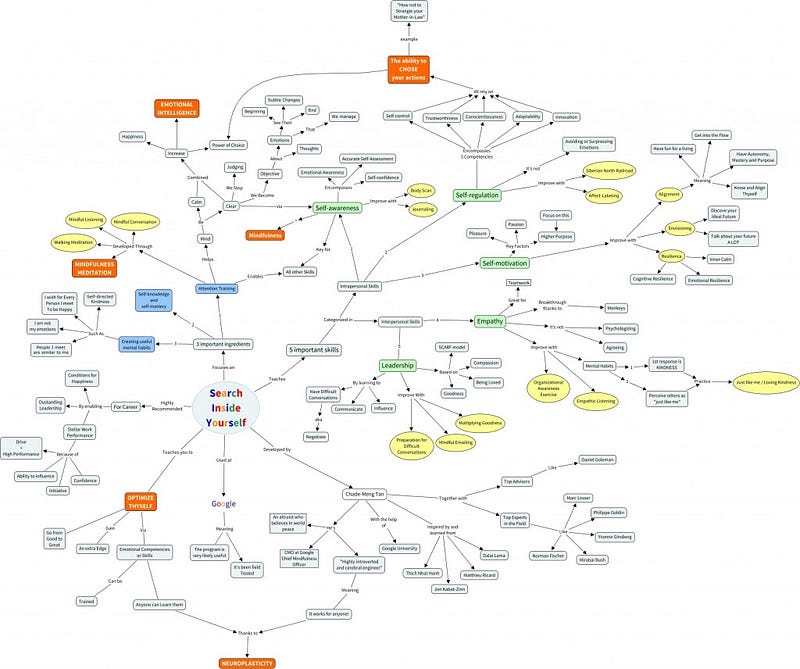So we know about the benefits and a bit about the brain science. Now the interesting part. Check this out:
Daily 10 minute exercise to increase your Emotional Intelligence
“Begin by sitting comfortably. Sit in a position that enables you to be relaxed and alert at the same time, whatever that means to you. Now take three slow, deep breaths to inject both energy and relaxation into our practice. Now, breathe naturally and start focus your attention in your breath, being conscious of it. You can either focus on your nostrils, the abdomen or your chest and lungs. Become aware of inhaling, exhaling and the in-between. If you like, you can think of this exercise as being aware of your breathing. You can think that breathing is a resting place, a cushion or a mattress and let the mind rest on it, very gently. Just keep breathing. If at any time you feel distracted by a sensation, thought, or sound, just acknowledge it, experience it, and let it go smoothly. Bring your attention effortlessly back to breathing.”
10 minutes of this simple exercise a day is all you have to do to start developing your Emotional Intelligence. At least, that’s what Chade-Meng Tan suggests we should begin with in his book “Search Inside Yourself”.
Think you have 10 minutes for that? In the words of Anthony Robbins, if we don’t have 10 minutes a day to exercise our mind, we don’t have a life. That’s a bit radical, but given the benefits from such a tiny time investment, I really don’t see why you shouldn’t do it.
If you think you can’t, stop reading right now. There are about 17 practices to develop all sorts of skills in the book, and this is the core. Without it, we can’t develop our Emotional Intelligence. At least, not this way.
Exercise for the mind
Cardio is a good analogy for this training. If we get tired after only 5 minutes weightlifting, we can’t progress. We’ve got to start from beginning and develop our endurance, learn how to breathe and have our body prepared for physical exercise. If we have sedentary life, we can’t just decide to run 10 km or lift 100 kg. There’s a progression we must follow, and mind training is no exception.
If we aren’t able to focus our attention long enough on anything, we can’t do any of the advanced exercises in the book. Chade suggests we begin by developing the ability to control our attention. He even recommends a simpler exercise to begin with: just sit for 2 minutes idly. Just be, quietly, focused in your breathing. Be aware of what you’re doing. That’s the basis of mindfulness meditation. The 10 minute breathing exercise brings more benefits though and, really, it’s only 10 min per day. There’s no need to even get dressed, sweat or take a shower, like we need when we do physical exercise, right?
On the flip side, if we commit to doing this awesomely simple exercise, the results are HUGE!
It’s no surprise that, if you look at the habits of some of the world’s most successful people, almost everyone of them include some form of meditation when they wake up. From Tim Ferris to Anthony Robbins (that we mentioned before). Arnold Schwarzenegger practised a type of meditation too (transcendental meditation) for a year. He had a super successful real estate business (he was already a millionaire before he became a movie star), was doing great with his body-building and his actor career kicked off. He was overwhelmed. He had a hard time separating the three and focusing on each one when needed. So he trained his mind.
The interesting thing is, unlike the body, which requires constant exercise and eventually deteriorates with age, he says he still reaps the fruit of that one year of meditation practice until today.
Mindfulness for better Emotional Intelligence
But wait, we’re talking about mindfulness meditation, how does that lead to better emotional intelligence? Well, “mindfulness is the skill that gives you the faculty of voluntarily bringing back wandering attention over and over again.” or, as defined by Jon Kabat-Zin, “paying attention in a particular way: on purpose, in the present moment, and non-judgementally.”
Once we develop our attention, we focus on our body during the exercise, we gain clarity over the emotions we feel. We notice them the moment they arise, release them, notice the subtle changes in-between and start to see them more vividly. We gain self-awareness. Of the 5 skills involved in emotional intelligence, self-awareness is the one that all the others depend on. That’s an insight that blew Chade’s mind. Something as simple as meditation can be used to reap all the benefits of high Emotional Intelligence.
But he didn’t stop there. He developed a whole curriculum, a course that employees at Google get to go through.
Sustain your practice
One thing he mentions is how easy it is to get someone to start practising. Sustaining the practice over time, however, is not as easy. During the first few months it might be really hard. After that, though, it becomes a habit self-reinforced by the improvement in quality of life. To get through the hard period, he has 2 suggestions. We could get a buddy, someone accompany and hold us accountable. We could schedule a 15 min conversation every week, to check how the commitment to the practice is going, and to analyse changes in life that stem from the practice. Sort of like a weekly Scrum meeting.
He also suggests we do less than we can. It’s the same advice told to people that likes to do jogging: you shouldn’t run until exhaustion. We should feel good from running, at least in the beginning, until the practice becomes a habit. Same here, no one says this should a 10 minute exercise right from the beginning. Start with 1 min, but do it consistently. Or just take one mindful breath a day, until you’re ready for more and then evolve from there. Practice is key.
The good thing is, as a baby that’s learning how to walk, we’ll be taking 1–2 steps for a while, since we won’t be able to focus on our breathing for long. Once we reach the end stage, we evolve exponentially, being able to summon a state of mind on demand, at a desired intensity and duration. Our mind is then trained and ceases to be a slave to the will of primitive elements such as the amygdala, who, if it had its way, would have us run and jump at every sign of danger or fear.
Is this it?
This is just the start. From there, you learn that emotional awareness leads to accurate self-assessment, which leads to self-motivation and self-confidence. Then we’ll work on self-regulation and get to a point where we’re no longer compulsive. Instead, our reactions become our choice. We learn to take a moment, breathe and think about the proper reaction have in any given situation. There’s actually a chapter in the book called “How to not strangle your mother-in-law”. You know that, if you can do that, you can do anything!
There’s much more to the book than that, but here is my suggestion: we’ll publish the next step in our next post. Until then, commit to do the simple exercise suggested. I’d be happy to help with any questions you might have, so feel free to reach out, on twitter or by email.
If you’d prefer to invest a bit of money and get something structured, a seemingly cool course about mindfulness just popped up on Udemy. It’s taught by Thich Nhat Hanh, who’s been teaching mindfulness for decades, and who Chade worked with for his book.
I leave you with a mindmap of the book contents.

You can get an idea of the breadth of the book. Although it seems complicated, all the exercises suggested are super simple. All it takes is a bit of work and dedication. Are you up for it?
Cheers,
Zoran Vitez
Looking for your next challenge?






0 Comments